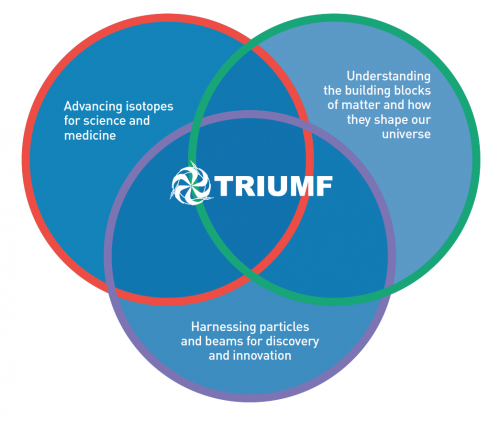
Five-Year Plan 2015–2020 represents a defining document for TRIUMF. Not only does it recap the performance of the five years—2008–2012—it also presents an implementation plan for the second half of the decadal vision laid out in Five-Year Plan 2010–2015. That vision encompassed plans and goals for several different constituents: TRIUMF, scientists, and industry, as well as everyday Canadians. We have organized this report to appeal to a variety of audiences, with a variety of needs and goals.
To view and read the entire TRIUMF Five-Year Plan 2015–2020 (and more about the report-writing process), please go here.
Chapters 1, 2 and 3 will interest political staff, government policy makers, and intellectual leaders and experts. These chapters provide an overview of how TRIUMF plans to advance, even further, its work inservice of the national agenda. Chapters 4 to 6 will attract the more technically advanced reader, theoretical and experimental physicists and academics, as well as those with a familiarity with modern subatomic physics. These chapters provide the evidentiary basis for assessing TRIUMF's performance over the past five years and determining what comes next.

It may come as no surprise that the new Five-Year Plan for TRI-UMF employs the number three in three different ways: three themes, three benefits of science, and three scenarios. Briefly, Five-Year Plan 2015-2020 is organized around three cross-cutting themes that thread through the core of the proposed program (see ring diagram to the right). Additionally, the report documents how the proposed program will drive three different categories of benefit to Canada: advancing knowledge, creating the next generation of leaders (e.g., "HQP"), and driving societal and economic growth. At its core, TRIUMF continues to be a basic-research laboratory. Finally, the report also provides three different budget scenarios that help tease out the priorities and strategies to provide the best value for Canada in the near and long-term. Read the book to learn more!

The strategic-planning process cannot be done in isolation, and it is the most successful when the community plays an important and substantive role. Some individuals responded far beyond the ordinary call of duty to shoulder the thoughtful and soul-searching work to assemble this plan. They are: Nigel Lockyer, Reiner Kruecken, Byron Jennings, Jens Dilling, Hiro Tanaka, Isabel Trigger, Sampa Bhadra, Lia Merminga, Paul Schaffer, Colin Gay, Iain Mackenzie, Ken Ragan, Khashayar Ghandi, Carsten Krauss, and Paul Garrett. Finally, the entire manuscript here would never have made any sense without the efforts of Melva McLean, Melissa Baluk, and Jennifer Gagne, along with critical contributions from Gabriel Baron and Ariane Madden.
I wholeheartedly acknowledge everyone fortheir contributions and incredible commitment to TRIUMF, the progress ofscience, and Canadian excellence. The future is bright.
On behalf of the Five-Year Plan Steering Committee,
-- T.I. Meyer, Head, Strategic Planning & Communication
